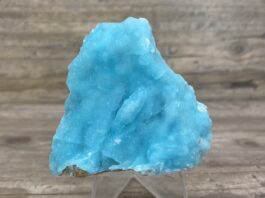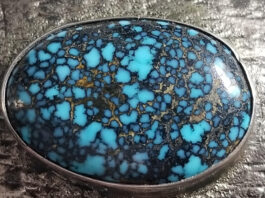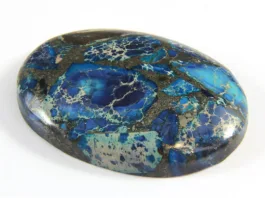Indicolite is a term primarily used in the world of gemology to refer to a specific variety of the mineral tourmaline. Tourmaline is a complex boron silicate mineral with a wide range of colors and compositions, and indicolite represents one of its variations in color.



The term “indicolite” is derived from the Latin words “indicum,” meaning “indigo” or “blue,” and “lithos,” meaning “stone.” As the name suggests, indicolite is characterized by its varying shades of blue, ranging from pale blue to deep blue-green. This coloration is due to trace amounts of iron within the tourmaline’s crystal structure.
Indicolite tourmalines are popular and prized gemstones, valued for their vivid and appealing blue colors. Their color intensity and saturation can vary widely, impacting their desirability and value. The clarity, cut, and size of an indicolite gemstone also contribute to its overall worth.
Indicolite, like other tourmaline varieties, is often used in jewelry such as rings, necklaces, earrings, and bracelets. Its unique blue hues make it a favorite among collectors and consumers who appreciate the diversity of gemstone options beyond the more commonly recognized gemstones like sapphires or aquamarines.
Gemologists and jewelry enthusiasts appreciate indicolite not only for its aesthetic qualities but also for its connection to the mineral kingdom’s diversity and the geological processes that give rise to such beautiful and unique creations.
Geological formation and sources

Indicolite tourmaline, like other tourmaline varieties, is formed through complex geological processes involving heat, pressure, and the interaction of various elements within the Earth’s crust. Tourmaline is a borosilicate mineral, and its formation is influenced by the presence of elements such as boron, aluminum, silicon, and others.
Indicolite tourmaline typically forms in pegmatite veins, which are coarse-grained igneous rocks that are often enriched with rare minerals due to the slow cooling and crystallization of magma. These pegmatite veins can be found in a variety of geological settings, such as mountain ranges, granitic intrusions, and metamorphic terrains.
The process of indicolite formation can be summarized as follows:
- Magma Intrusion: Molten magma from the Earth’s mantle rises towards the surface. As it cools and solidifies, it forms granitic intrusions, including pegmatite veins.
- Enrichment of Elements: Pegmatites are known for their slow cooling, which allows for the formation of large mineral crystals. During this process, elements like boron, which is a key component of tourmaline, become concentrated within the pegmatite.
- Mineral Precipitation: As the pegmatite cools further, the elements necessary for tourmaline formation begin to combine and crystallize. The presence of iron impurities gives rise to the blue coloration in indicolite.
- Crystal Growth: Over time, tourmaline crystals grow within the pegmatite. These crystals can vary in size, and the conditions during their growth influence the color and clarity of the resulting gemstones.
- Erosion and Exposure: Geological processes such as erosion and tectonic movements can expose these pegmatite veins at the Earth’s surface. This can lead to the discovery of indicolite-bearing rocks.
Indicolite tourmaline is found in various parts of the world, including but not limited to:
- Brazil: Brazil is a significant source of indicolite tourmaline, especially from mines in Minas Gerais.
- Madagascar: Madagascar is known for producing high-quality indicolite tourmaline.
- Nigeria: Nigeria is another African country that yields indicolite tourmaline.
- Mozambique: This African nation is also a notable source of blue tourmaline, including indicolite.
- Afghanistan: Indicolite tourmaline has been found in the Panjshir Valley.
It’s important to note that the availability and sources of gemstones can change over time due to factors such as mining activities, new discoveries, and geopolitical situations. Gemstone mining and trade are influenced by various economic, social, and environmental factors.
Contents
Physical and Chemical Properties

Tourmaline Mineral Group: Tourmaline is a complex borosilicate mineral group with a wide range of chemical compositions and colors. It’s known for its remarkable diversity in color, which can include not only blue (indicolite) but also green, pink, red, brown, and even colorless varieties. The tourmaline group encompasses a family of closely related minerals with similar crystal structures but varying chemical compositions that lead to different colors.
Crystal Structure and Composition: The crystal structure of tourmaline is quite intricate. It is a cyclosilicate, meaning it has rings of interconnected silicate (SiO4) tetrahedra. The general chemical formula for tourmaline is complex due to the presence of various elements that can substitute for one another. The basic formula can be written as XY3Z6(T6O18)(BO3)3V3W. Here’s what each variable represents:
- X, Y, Z: These are cation sites where different elements can substitute. X and Y can be elements such as sodium, calcium, lithium, and more. Z can include elements like aluminum, iron, chromium, and others.
- T: This represents a tetrahedral site that can be occupied by silicon or aluminum.
- BO3: This is the borate group.
- V, W: These are anion sites that can also be occupied by various elements.
The combination of different elements in these sites results in the wide array of colors and variations seen in tourmaline, including indicolite.
Factors Influencing Color Variation: The color of tourmaline, including indicolite, is influenced by several factors:
- Trace Elements: The presence of trace elements, particularly transition metals like iron, manganese, and chromium, can significantly impact the color of tourmaline. In the case of indicolite, the blue color is primarily attributed to the presence of iron in the crystal structure.
- Oxidation State: The oxidation state of the trace elements affects the color. For example, iron in different oxidation states can produce blue, green, or brown hues.
- Crystal Chemistry: The arrangement of elements within the crystal lattice and the specific cation sites they occupy play a role in color variation.
- Light Absorption: The interaction of light with the trace elements within the crystal lattice leads to the absorption of certain wavelengths of light and the reflection of others. This absorbed-reflected light determines the perceived color.
- Color Centers: Structural defects in the crystal lattice, often related to radiation or heat, can create color centers that contribute to the gemstone’s color.
It’s important to note that minor variations in chemical composition and crystal growth conditions can result in a range of colors within a single tourmaline variety, such as indicolite. This diversity is part of what makes tourmaline a fascinating and prized gemstone group.
Gemological Characteristics

Gemological characteristics are essential aspects used to evaluate and identify gemstones, including indicolite tourmaline. These characteristics help gemologists and jewelers determine a gemstone’s identity, quality, and value. Here are some key gemological characteristics specific to indicolite tourmaline:
- Color: The primary identifying feature of indicolite is its blue color, which can range from pale blue to deep blue-green. The color’s intensity, saturation, and uniformity are crucial factors in evaluating the gem’s quality.
- Clarity: Clarity refers to the presence of internal inclusions and external blemishes within the gemstone. Indicolite tourmalines, like many gemstones, can have various types of inclusions, such as needles, fractures, or other minerals. Higher clarity grades are more desirable.
- Cut: The cut of a gemstone affects its brilliance, sparkle, and overall appearance. Indicolite tourmalines are often cut into various shapes, including emerald cuts, oval cuts, cushion cuts, and more. The cut should be well-proportioned to maximize the gem’s beauty.
- Carat Weight: Carat weight measures the size of the gemstone. Indicolite tourmalines, like other gemstones, can vary in size, and larger, well-cut stones are often more valuable. However, smaller stones with exceptional color and clarity can also be valuable.
- Transparency: Transparency refers to how much light passes through the gemstone. Indicolite tourmalines are usually transparent to translucent, allowing light to enter and interact with the gem’s internal structure.
- Pleochroism: Many tourmalines, including indicolite, exhibit pleochroism, which means they can display different colors when viewed from different angles. Gemologists often examine indicolite tourmalines under different lighting conditions to observe this property.
- Luster: Luster describes the way light interacts with the surface of the gemstone. Indicolite tourmalines typically have a vitreous (glassy) to resinous luster.
- Specific Gravity: Specific gravity is the ratio of a gemstone’s weight to the weight of an equal volume of water. Indicolite tourmalines have a specific gravity that falls within a certain range, helping to distinguish them from other gemstones.
- Refractive Index: Refractive index measures how much light bends as it enters the gemstone. Indicolite tourmalines have a refractive index within a specific range, aiding in their identification.
- Durability: Indicolite tourmalines are relatively durable with a hardness of 7 to 7.5 on the Mohs scale. While not as hard as sapphires or diamonds, they are suitable for most types of jewelry.
- Fluorescence: Some tourmalines, including indicolite, can exhibit fluorescence when exposed to ultraviolet (UV) light. This property can vary, and it’s an interesting aspect to consider in gemological examinations.
Overall, gemological characteristics help professionals determine the authenticity, quality, and value of indicolite tourmaline, enabling informed decisions for jewelry creation and investment.
Indicolite in Jewelry

Indicolite tourmaline is a popular and captivating gemstone choice for various types of jewelry due to its unique blue hues and gemological properties. Here’s how indicolite tourmaline is used in jewelry:
- Rings: Indicolite tourmaline rings are a popular choice for those seeking a distinctive and colorful gemstone for their engagement rings, wedding bands, or fashion rings. The blue color of indicolite can vary from subtle pastels to deep, rich shades, offering a wide range of options for personal preferences.
- Necklaces and Pendants: Indicolite tourmaline pendants and necklaces showcase the gem’s color beautifully when worn close to the neckline. They can be set in various styles, such as solitaire pendants, halo settings, or even as part of more intricate designs.
- Earrings: Indicolite tourmaline earrings, whether studs, dangles, or hoops, add a touch of elegance and color to any outfit. They can be matched with other indicolite jewelry or complemented with contrasting gemstones.
- Bracelets: Indicolite tourmaline bracelets can be crafted with a single strand of stones or incorporated into multi-stone designs. Tennis bracelets, bangles, and cuffs can all feature the striking blue hues of indicolite.
- Jewelry Sets: Some individuals opt for indicolite tourmaline jewelry sets, which include matching pieces like earrings, necklaces, and rings. These sets offer a cohesive look and allow for easy coordination of accessories.
- Custom Designs: Many jewelers offer custom design services, allowing individuals to create one-of-a-kind pieces that incorporate indicolite tourmaline along with other gemstones and precious metals.
- Birthstone Jewelry: Indicolite tourmaline is considered one of the modern birthstones for October, making it a meaningful choice for those born in that month. Birthstone jewelry featuring indicolite can have personal significance.
- Collector’s Pieces: Collectors often seek out high-quality indicolite tourmalines due to their rarity and unique color. Some indicolite gemstones might not be cut into traditional shapes, as the goal might be to showcase the stone’s natural beauty rather than conform to standard jewelry designs.
When choosing indicolite tourmaline for jewelry, factors such as color intensity, clarity, cut, size, and overall design should be considered. Indicolite’s blue shades can complement various metals, including white gold, yellow gold, rose gold, and platinum, allowing for versatile jewelry creations.
As with any gemstone, it’s recommended to work with reputable jewelers who provide accurate information about the gem’s quality, origin, and any treatments that might have been applied. This ensures that you’re making an informed decision and investing in a piece of jewelry that you’ll cherish for years to come.
Famous Indicolite Gemstones

While there are no globally renowned indicolite gemstones that hold the same level of recognition as, say, the Hope Diamond or the Star of India, there are still notable indicolite tourmalines that have gained recognition in the gemstone and jewelry world. Their historical and cultural significance may not be as extensive, but they contribute to the appreciation of these beautiful blue gemstones.
- The “Subway Token” Indicolite: This famous indicolite tourmaline gained its nickname due to its remarkable similarity in color to the old New York City subway tokens. It’s a 191.87-carat indicolite that was discovered in the mid-1990s in Brazil. This gemstone showcases the rich blue-green hues typical of indicolite, making it a sought-after collector’s piece.
- The “Blue Giant of the Orient”: While not exclusively an indicolite, this gemstone is a large and valuable blue tourmaline from Madagascar. It exhibits a deep blue color that is often associated with indicolite, although it might fall into the category of blue tourmalines more broadly. Its significance lies in its impressive size, color, and the rarity of such large and fine-quality blue tourmalines.
- Private Collections and High Jewelry: Many famous indicolite gemstones are likely held in private collections or have been incorporated into high-end jewelry pieces. These gemstones might not have historical or cultural narratives as publicly known as some other gemstones, but their exceptional beauty and rarity contribute to the appreciation of indicolite as a unique and valuable gemstone.
It’s important to note that gemstone fame often comes from factors beyond just the gem’s quality, size, or color. Historical narratives, cultural symbolism, and famous owners play a significant role in elevating the status of a gemstone. While indicolite tourmalines might not have extensive historical stories or cultural significance like some other gemstones, their individual beauty and appeal continue to captivate gem enthusiasts, collectors, and jewelry designers.






